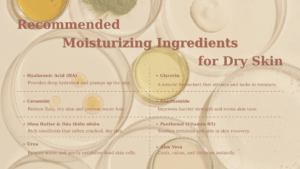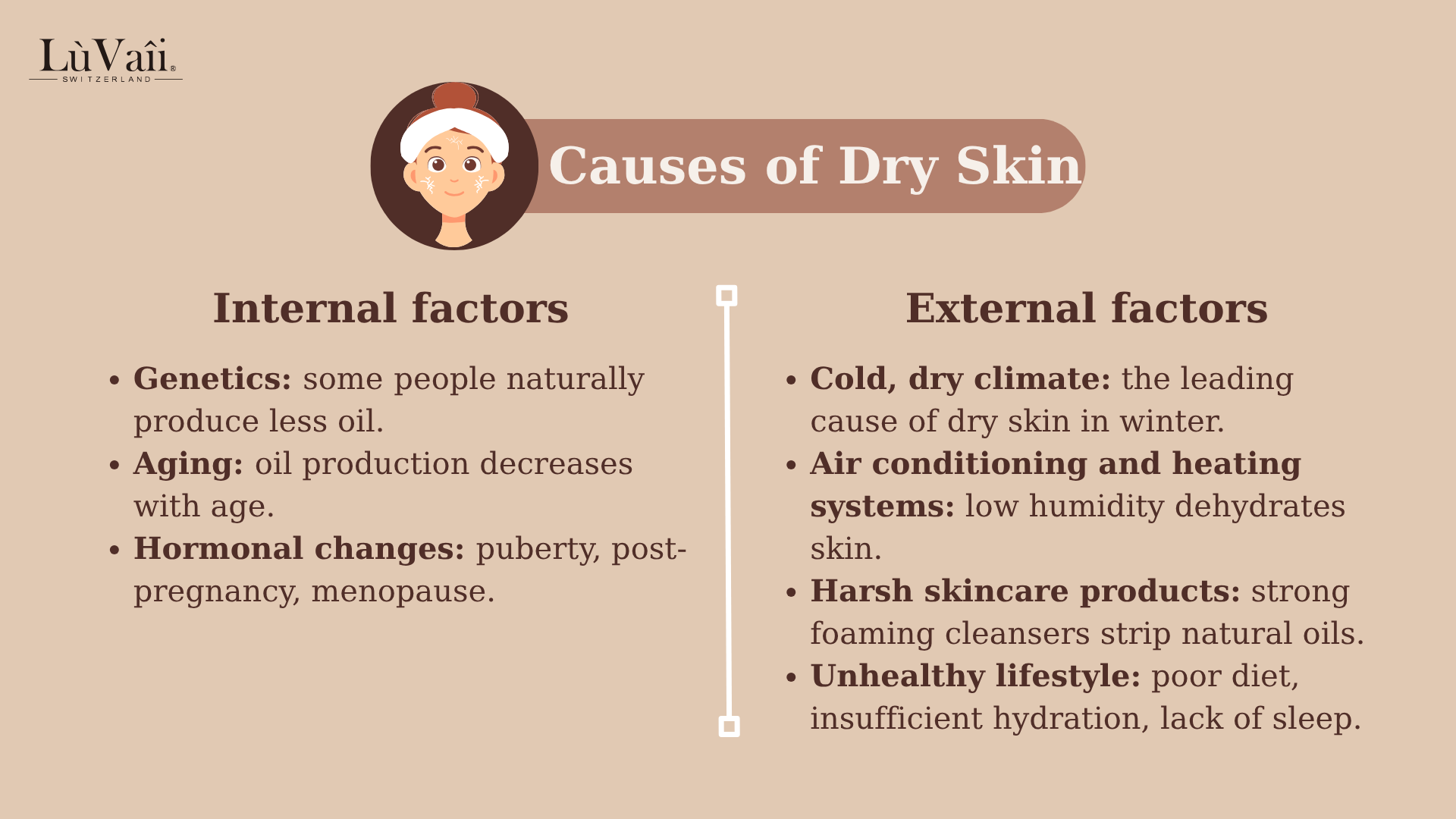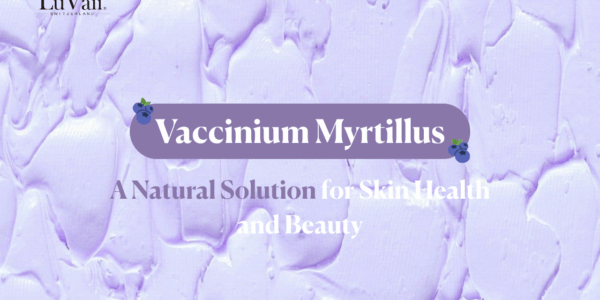
Table of content
Introduction
Dry skin is one of the most common skin concerns, affecting people of all ages and genders. It not only causes discomfort such as tightness and flakiness but also makes the complexion appear dull and aged more quickly compared to other skin types. During dry winter months or in air-conditioned environments, this condition can worsen, reducing confidence in daily life and interactions.
By understanding the causes and identifying the early signs, you can take proactive steps to care for your skin. This article provides a comprehensive overview of dry skin: causes, care guidelines, common mistakes to avoid, and recommended moisturizing ingredients, helping you maintain healthy, supple skin over the long term.
What Is Dry Skin?
Dry skin occurs when the skin lacks natural oils and moisture, leading to rough texture, flakiness, and increased sensitivity. Unlike oily or combination skin, dry skin typically has smaller pores and produces less sebum, making it more prone to fine lines and premature aging.
Common characteristics
- Flaky or peeling skin after cleansing.
- Rough surface with little to no natural oil.
- Small, nearly invisible pores.
- Fine lines forming earlier than in other skin types.
- Makeup often appears patchy or cakey.
Causes of Dry Skin
Internal factors
- Genetics: some people naturally produce less oil.
- Aging: oil production decreases with age.
- Hormonal changes: puberty, post-pregnancy, menopause.
External factors
- Cold, dry climate: the leading cause of dry skin in winter.
- Air conditioning and heating systems: low humidity dehydrates skin.
- Harsh skincare products: strong foaming cleansers strip natural oils.
- Unhealthy lifestyle: poor diet, insufficient hydration, lack of sleep.
Signs of Dry Skin

- Frequent tightness and flakiness.
- Rough texture when touched.
- Early appearance of fine lines.
- Easily dehydrated and irritated.
- Makeup does not adhere smoothly.
Care Principles for Dry Skin
- Moisturize consistently with products containing hyaluronic acid, glycerin, and ceramides.
- Use a gentle cleanser for dry skin, preferably low-foam and pH-balanced.
- Add a hydrating serum for dry skin to target dehydration.
- Sunscreen for dry skin should be enriched with hydrating ingredients.
- Eat a nutrient-rich diet and drink enough water daily.
- Avoid prolonged hot showers or washing with very hot water.
Common Mistakes When Caring for Dry Skin
Using harsh cleansers
- High-alkaline or sulfate-based products strip essential oils.
- This worsens dry, flaky skin and disrupts skin balance.
Skipping moisturizer
- Relying only on toner or serum without sealing in hydration with moisturizer for dry skin leads to water loss.
Over-exfoliating
- Excessive scrubbing or chemical exfoliation damages the barrier, leaving skin thinner and more sensitive.
Forgetting sunscreen
- UV damage accelerates aging, even if dry skin doesn’t appear oily.
Choosing products with alcohol or fragrance
- These irritants intensify cracked, dry skin and sensitivity.
Recommended Moisturizing Ingredients for Dry Skin

Hyaluronic Acid (HA)
- Binds up to 1000 times its weight in water.
- Provides deep hydration and plumps up the skin.
Glycerin
- A natural humectant that attracts and locks in moisture.
- Frequently found in moisturizers for dry skin.
Ceramides
- Essential for repairing the skin barrier.
- Reduce flaky, dry skin and prevent water loss.
Niacinamide (Vitamin B3)
- Improves barrier strength and evens skin tone.
- Helps retain hydration while brightening the complexion.
Shea Butter & Plant Oils (Jojoba, Almond, Argan)
- Rich emollients that soften cracked, dry skin.
- Replenish lost lipids and smooth rough patches.
Panthenol (Vitamin B5)
- Soothes irritation and aids in skin recovery.
- Common in serums and barrier creams.
Urea
- Retains water and gently exfoliates dead skin cells.
- Enhances softness and smoothness.
Aloe Vera
- Cools, calms, and hydrates instantly.
- Ideal in toners, gels, and lightweight lotions.
Best Foods for Dry Skin
- Fatty fish such as salmon and mackerel (rich in omega-3).
- Nuts like almonds and walnuts (rich in vitamin E).
- Fresh vegetables and citrus fruits (high in vitamin C).
- Drink at least 2 liters of water daily to stay hydrated.
How to Restore Dry, Flaky, or Cracked Skin
- Cleanse gently without harsh foaming products.
- Apply a hydrating serum immediately after cleansing.
- Lock in hydration with a nourishing moisturizer.
- Use hydrating sheet masks 2–3 times per week.
- Protect skin from wind and direct sunlight.
FAQs
What is dry skin and how can it be recognized?
Dry skin is a condition where the skin lacks oil and moisture, showing signs like flakiness, tightness, and cracking.
What causes dry skin?
It may be due to genetics, aging, hormonal changes, or environmental and lifestyle factors.
Should people with dry skin use serums?
Yes, a hydrating serum for dry skin delivers intensive hydration and supports barrier recovery.
What are common mistakes in caring for dry skin?
Over-exfoliating, skipping sunscreen, using harsh cleansers, or neglecting moisturizer.
Which ingredients are recommended for dry skin care?
Hyaluronic acid, glycerin, ceramides, niacinamide, panthenol, and shea butter.
Does dry skin need sunscreen?
Yes, sunscreen for dry skin is essential to protect against UV damage and premature aging.
Which foods improve dry skin?
Omega-3-rich fish, vitamin E-rich nuts, and vitamin C-rich fruits and vegetables.
How can I quickly soothe cracked, dry skin?
Hydrate with serum and moisturizer, use a hydrating mask, and stay well hydrated.
Conclusion
Dry skin may be uncomfortable and frustrating, but with proper care, it can be significantly improved. By understanding its causes, avoiding common mistakes, and choosing products with recommended moisturizing ingredients for dry skin, you can restore a healthy, supple, and radiant complexion.
A healthy lifestyle, combined with a balanced diet and proper skincare habits, is the key to help dry skin healthy, preventing permature aging, and maintaining daily confidence.




